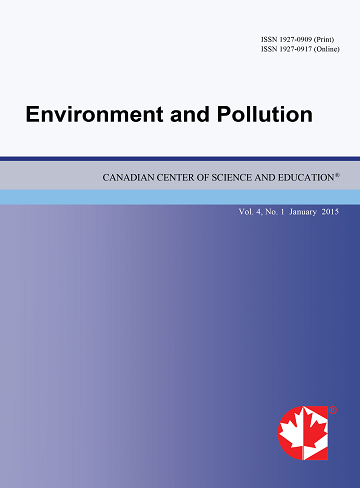Environmental Geochemistry of Mine Tailings Soils in the Artisanal Gold Mining District of Betare -Oya, Cameroon
- Veronica Manga
- Gladys Neba
- Emmanuel Suh
Abstract
Changes in trace element concentrations in mine tailings (dry and wet) were investigated in the gold mining area of Bétaré-Oya, Eastern Cameroon. Forty-one surface sediment samples were analyzed using ICP-MS for heavy metals and pollution was assessed using Enrichment Ratio and Geo Accumulation Index (Igeo); using a sample from a remote area as control.Trace elements in mine tailings show significant increase compared to the background (control) values, with the exception of Sr and Nb. It is suggested that allochtonous deposition may account for Sr distribution. A strong correlation is observed between the lithophile elements; Y, Nb, Ce, La, and Pb. Their association with each other is also strong, i.e. Nb/Ce (.73) and La/Ce (.63). The close association of these elements in the samples may be an indication of the effect of resistant heavy minerals from felsic rocks (mainly granites and gneisses). Cu, Zn, Sr and Ba distribution is associated with mineralisation of sulphide-bearing minerals and clay formation from weathering of mica schist. Cu, Zn, As, W, Mo and Ag have been identified as potential pollutants. Compared to the Dutch soil quality guidelines, these elements are above the target values and below the intervention levels. Arsenic is considered to be the most threatening element, with regards to its potency. The distribution of As in this area appears to be controlled by mining activities.
- Full Text:
 PDF
PDF
- DOI:10.5539/ep.v6n1p52
Journal Metrics
h-index (2017): 10
i10-index (2017): 11
h5-index (2017): 9
h5-median (2017): 15
Index
- Academic Journals Database
- Berkeley Library
- CAB Abstracts
- CAS (American Chemical Society)
- CNKI Scholar
- COPAC
- CrossRef
- DTU Library
- Elektronische Zeitschriftenbibliothek (EZB)
- EuroPub Database
- Excellence in Research for Australia (ERA)
- Genamics JournalSeek
- Google Scholar
- Harvard Library
- Infotrieve
- Jisc Library Hub Discover
- JournalGuide
- JournalTOCs
- LOCKSS
- Max Planck Institutes
- Mir@bel
- PKP Open Archives Harvester
- Pollution Abstracts
- Publons
- Pubmed journal list
- ROAD
- Scilit
- SHERPA/RoMEO
- Standard Periodical Directory
- Stanford Libraries
- UCR Library
- Ulrich's
- UniCat
- Universe Digital Library
- UoS Library
- WorldCat
- Zeitschriften Daten Bank (ZDB)
Contact
- Albert JohnEditorial Assistant
- ep@ccsenet.org
